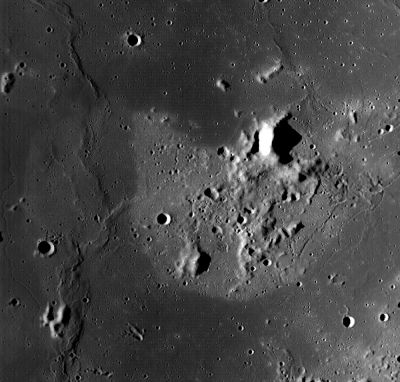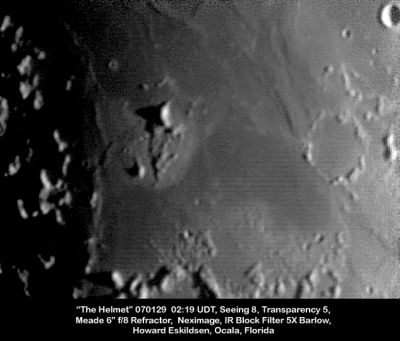The Helmet
Contents
The Helmet
(unofficial name; formerly in part Herigonius Eta and Pi)
|
Lat: 16.6°S, Long: 31.4°W, Diameter: 55 km, Depth: km, Rukl 52 | |
Right: LROC image WAC No. M117704509ME (calibrated by LROC_WAC_Previewer).
Images
LPOD Photo Gallery images Lunar Orbiter Image Apollo Images
- A wonderful assembled Hasselblad-panorama, made by the dedicated lunar observer Bob Pilz, shows a southward view of The Helmet, photographed by one of the orbiting astronauts of Apollo 16. - DannyCaes Dec 8, 2007
- The last photographs of Apollo 16's Revolution 48 (Mapping/Metric Fairchild-camera photographs) show The Helmet at the sunrise terminator (with hill Herigonius Eta's eastern slope in full sunlight).- DannyCaes Oct 17, 2008
Maps
(LAC zone 93B2) LAC map Geologic map
Description
- Diviner IR data identifies this (the Helmet) as one of the most silica-rich volcanic regions of the Moon. (Glotch et al, , 2010).
- The reddish coloration of the Helmet is noticeable on the LROC's WAC albedo/color map, see: http://bit.ly/1AMQYJl
Additional Information
- LO-IV-132H indicates the head of the duck (Herigonius Eta -- see Nomenclature, below) is at least 1100 m tall, but this is only a limit because the tip of the shadow, in that photo, doesn’t reach all the way to the mare. Consolidated Lunar Atlas Plate E18, where the shadows are longer, puts the full height of Herigonius Eta at around 1300 m, and Herigonius Pi at about 600 m. Ignoring such isolated peaks, the main body of the duck does not seem much more than 100 m tall. - JimMosher
Nomenclature
It's outline suggested the name to geologists who needed a handy designation to refer to the object they were studying.
- As pointed out by Henrik Bondo, at low sun the raised eastern part of the Helmet very much resembles a vertical view of a northward-swimming duck, with the highest part being its head. There are even some ducklings in tow to the south and west. - JimMosher
- In the original IAU nomenclature of Blagg and Müller, the raised head of the duck was known as Herigonius Eta. In the System of Lunar Craters the designation Herigonius Pi was added for the main duckling (the one just west of the tail). Both of these designations (Eta and Pi) were deleted in 1973 when the IAU dropped all the Greek letters. Neither of these has been officially renamed. Although once named after Herigonius, these features are actually closer to the primary named crater Agatharchides. The "Helmet" designation used by the geologists pertains to the larger light area around the ducks and extending to the west. - JimMosher
- On Van Langren's map it (the Helmet) seems to have been called Contarini, on Grimaldi's map it was Riccioli's Morinus. The irregular clusters of hills and hillocks between the Helmet and Gassendi (aka Rand McNally's Andreus hills) were called Badvari and Cornaro by Van Langren. - DannyCaes Feb 12, 2016
LPOD Articles
Herigonius Pi and Eta A Colorful Helmet Full Moon Secrets
Bibliography
- Bondarenko, N. V.; Shkuratov, Yu. G. (2000) Helmet Formation on the Moon LPSC 31 #1146.
- Glotch, T.D. and others (2010) Highly Silicic Compositions on the Moon. Science 329 no. 5998 pp. 1510-1513.
- Wagner, R.; Head, J. W., III; Wolf, U.; Neukum, G. (2004) The Hansteen and Helmet Volcanic Dome Regions on the Moon: Stratigraphy and Ages. Lunar & Planet. Sci. 35, 1842.

